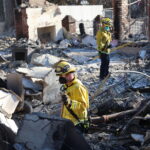Proposed federal rules to make hauling crude oil by rail safer and avoid fiery wrecks would drive up costs and put the U.S. energy revival at risk, the head of an oil industry trade group said.
The American Petroleum Institute joined by the Association of American Railroads today proposed keeping older tank cars, which investigators say are vulnerable to puncture, in service for twice as long as envisioned by regulators drafting rules for carrying flammable liquids like oil on trains.
The Transportation Department proposal to phase out older cars known as DOT-111s in two years is “not feasible,” said Jack Gerard, executive director of the Washington-based API, which represents companies including Exxon Mobil Corp. and Chevron Corp.
The rules “could stifle North America’s energy renaissance and curtail substantial volumes of U.S. and Canadian oil production,” Gerard said.
U.S. regulators drafted the rule after several accidents of oil tank cars, including a July 2013 derailment in Quebec that killed 47 people, and fiery explosions that rattled communities in North Dakota, Virginia and elsewhere. Today is the deadline to file comments with the agency, which may issue a final rule this year.
Surging Production
The regulators are considering tougher standards to account for an increase in the use of trains to carry flammable liquids, particularly crude oil from places like North Dakota’s Bakken field where production is soaring beyond the capacity of pipelines. U.S. carloads of oil jumped to 408,000 last year from 11,000 in 2009.
The American Petroleum Institute and Association of American Railroads, whose members include Berkshire Hathaway Inc.’s BNSF railway, suggested that DOT-111s be replaced or retrofitted within four years. Tank car makers would get as long as a year to increase the capacity of their rolling stock.
The Transportation Department’s proposal calls for older tank cars to be modified or scrapped within two years from the time the rule goes into effect.
The API-AAR also proposed that new tank cars have half-inch shells, or slightly thicker than the latest models and one- eighth of an inch thinner than options proposed by the Transportation Department.
Gerard said the proposal stems from conversations with companies that represent another component of the crude-by-rail business, the manufacturers of the tank cars.
Meeting Deadlines
At least one, the Greenbrier Companies of Lake Oswego, Oregon, thinks it can meet the timeline laid out by the Transportation Department.
Without an aggressive timeline, “we won’t move as quickly toward those safer standards as we otherwise might,” said spokesman Jack Isselman in an interview.
The company also said the 9/16th inch tank car shell suggested by the government offers significant safety benefits, a point disputed by the API and AAR proposal.
The amount of crude carried by railroads has climbed as U.S. oil production, which is at its highest point in three decades, has surged.
Accidents have also increased. There were five accidents in 2013, according to the Transportation Department. There have been another five so far this year. No accidents involving crude oil were reported in 2010.
The worst occurred in 2013 when an unattended train with more than 70 oil tank cars rolled into Lac-Megantic, Quebec, derailing and sparking a massive explosion that left 47 people dead.
The API, citing a study done by ICF International Inc., a consultancy based in Fairfax, Virginia, said the U.S. proposed phase-out could restrict the production and transportation of goods, costing consumers up to $45.2 billion.
Was this article valuable?
Here are more articles you may enjoy.

 Novogratz’s Galaxy to Pay $200 Million in NY Luna Settlement
Novogratz’s Galaxy to Pay $200 Million in NY Luna Settlement  State Farm Has Paid $2.5 Billion in Claims for LA Wildfires
State Farm Has Paid $2.5 Billion in Claims for LA Wildfires  After the Flames: Preparing for the Growing Fraud Threat in Los Angeles
After the Flames: Preparing for the Growing Fraud Threat in Los Angeles  Ticketmaster May Have Broken Law With ‘Platinum’ Oasis Seats
Ticketmaster May Have Broken Law With ‘Platinum’ Oasis Seats 